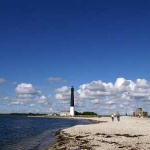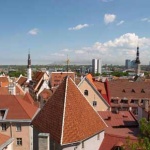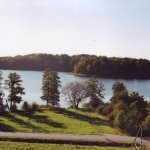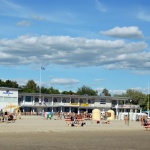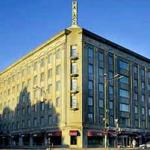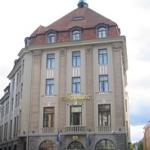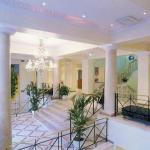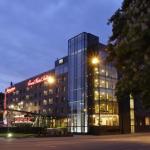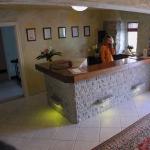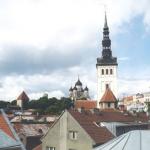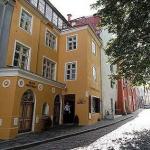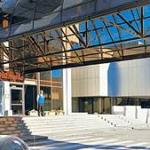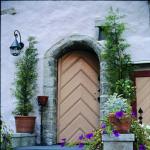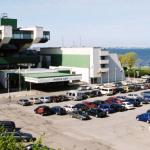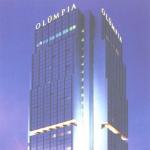Estonia Sights
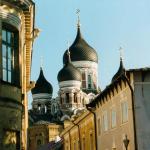 In Estonia, tourists come primarily to see the ancient and unique culture of this country, to visit the wonderful singing performances, which is so famous that land and rest on the seaside resorts of the Baltic coast.
In Estonia, tourists come primarily to see the ancient and unique culture of this country, to visit the wonderful singing performances, which is so famous that land and rest on the seaside resorts of the Baltic coast.North Estonia - the edge of sandy beaches and steep sea coast, the old ruins of the Order's estates and castles, fortified churches and monasteries, the edge of the mixing of cultures and turbulent history. In these places is limestone plateau of the North-Estonian limestone cliff, stretching along the northern coast of Narva to the Cape Pakri. Scattered limestone shore sloping gently to the sea (Cape Pakri), sometimes towering steep cliff (in Ontika - 56 pm). In covered only a thin layer of ground limestone plateau of unique fields of juniper bushes.
Tallinn - one of the best preserved medieval cities in Europe (the first time in written sources of this ancient settlement is mentioned in the Estonians in 1154). The historical city center - Old Town, is located on a hill of the ancient Toompea Vyshgorod numerous cathedrals, city walls and medieval towers, and situated south-east of the Lower City. Vyshgorodsky castle was built by the Crusaders in the XIII century., Repeatedly rebuilt, and today its main attractions are the Gothic Duomo di Toomkirk (XIII-XV centuries). With a massive baroque tower (XVIII cent.), Three corner towers (XIV-XVI cc.), including the famous Pikk Hermann (Tall Hermann ", XIV-XV cc.). Old houses with red tile roofs, winding and narrow streets, the remains of city walls, swept the roof and, of course, the business card Vyshgorod - many weathervanes - all this creates a unique color that part of the Estonian capital.
Lower Town (XIV-XVI centuries). In the Middle Ages and was surrounded by the city defenses, of which up to now remained only the numerous fragments of walls (XIII-XVI centuries.) And 18 towers (of 27) of which are of special interest Pax Margarethe ( "Fat Margaret", XVI cent.) with the exposition of the Naval Museum, Kiik-in-de-Kök ( "Look in the kitchen", XIV-XVI cent.) with a museum of ancient weapons, and the highest tower - Kuster. K Pax Margarethe adjacent arch Great Coastal Gate and on the other side of the street Pikk Jalg ( "The long leg, the oldest street in Tallinn) are famous at home" Three Sisters "(XV cent.), Huddled close to each other.
One of the main attractions of the city - the area Raekoya (Town Hall) with the Town Hall (1402-1404 gg.), Which posted another symbol of the city - the famous weather vane Vana Toomas (Old Thomas) and dozens of cafes and restaurants. Town Hall Square are a metal circle, symbolizing the center of Tallinn, as well as the oldest pharmacy in Europe. Be sure to visit the complex of buildings the Great Guild (XV cent.) House of the Brotherhood of Blackheads, "street-ladder Lühike Jalg (" Short Leg "), a monument to the sailors of the battleship" Mermaid "(1902) on the shore of the Gulf of Finland, street artisans Katarina , Viru Gates of the same name on the street with dozens of interesting shops, as well as the stratagem of narrow streets and arches of the Old City with residential merchant houses XV-XVI centuries.
In Tallinn, many churches, among which special attention is causing the Gothic Church of St. Olaus (St. Olaya, XV - the beginning. XVI centuries., The highest in the city and one of the highest in Europe) with its unique Gothic choirs, Nicholas (XIII-XV centuries. ) Pyuhavaymu (the Holy Spirit, XIV cent.) with a magnificent clock and a hanging chair ", a beautiful church of Alexander Nevsky and the Church of Our Lady of Kazan. Of no less interest is and built by Peter I for his wife's palace and park complex Kadriorg (1718-1736 gg.) With the Museum of Peter the Great Bay near the famous of the Song of the field. Now here is the residence of the President of Estonia, and in the halls of the palace holds regular chamber music concerts and exhibitions of fine art.
In Tallinn, more than 20 museums - the Museum of Applied Art, Work basement, the Maritime Museum, turret, Kiik-in-de-Kök, Nature Museum, Open Air Museum Rocca al Mare, Tallinn City Museum, National Museum of History, Estonian Art Museum near Toomkirk and others. Evenings open their speeches dozens of theaters, among them such well-known company, as the Russian Drama Theater, Opera and Ballet Theater "Estonia," Estonian Drama Theater, Gorrholl, Studio Old City, City Theater, Puppetry and Theater Von Kral.
Some coastal highway located venue for numerous exhibitions - "Flower" and "Blue" pavilions, and nearby - Olympic Village, a first-class Yacht Club Sailing Center and cozy beach at Pirita. In the green zone on the outskirts of the city located Tallinn Zoo, Luna Park in Kadriorg and Rocca al Mare Tivoli, a picturesque lake Ülemiste, the smallest castle in the Baltics - Tower Kiyu (1517), as well as suburban district Muga. At 33 km. the south-east of Tallinn, next to the well-known center of riding in Niytvyalya, is unique in the Baltic and the golf course with 18 holes.
Narva - (210 km. East of Tallinn), although severely damaged during the Second World War, but retained its main attractions - medieval Narva Castle (XIII-XV cc.), The city fortifications (XIV-XVI centuries.) Baroque Town Hall ( 1668-1671 gg.), the Orthodox Holy Week, the famous complex of buildings Krenholm factory and several houses XVII-XVIII centuries. Interesting Narva Museum in the fortress and a monument near the road Narva - Narva-Jõesuu dedicated to the dead during the liberation of the country in 1944 soldiers.
Most tourists follow in Tallinn, a transit passing this city. But much more interesting to combine the trip with a visit to Tallinn and Narva Ivangorod fortresses. Bus station Ivangorod is not more than 200 meters from the border with Estonia, a bridge across the Narva River. Straight from the bus station very visible on both the majestic fortress. Transition boundary does not take much time. Estonian border control is located on one side of the river to the left of the Narva Castle, and Russia - on the opposite side of the bridge, slightly to one side of the Ivangorodskoy fortress. Theoretically, if you're in Ivangorod, you can cross the bridge and visit the Narva Castle before the Estonian control.
A small cozy resort of Narva-Jõesuu located north of Narva, in a pine forest at the mouth of the river of the same name on the Gulf of Finland. Pine forests on dry sand dunes and the fresh sea air create a special healing microclimate, and the source of healing mineral water "Auga allows you to combine rest and treatment. Maximum sea beach with fine white sand stretches for 13 km. (7,5 of which are located within the city), and a picturesque river and the wooden buildings complement the charm of this resort.
In the vicinity of the historic lands of the province of Viru, there are many equally interesting places - Observation Tower and the memorial cross in Sinimäe, the pearl of the local landscape - a landscape park Auroux, Fire Museum Toila, church Pyuhayye (1838), the highest waterfall of the country -- Valaste (25 meters), the fortress Purtse (Izenheym, 1533), Mourning Park Victims of Evil in Hiyemyagi, cross Kyrkkyula after the Russian prince Roslandina, who was killed during the Russian-Swedish war (XVI cent.), a picturesque valley and the historic settlement in Padaorg, Castle Toolse (1471), Sea School and Museum in Käsmu, mansion Palms (1782-1785.), the historic town of Rakvere (www.rakvere.ee) with the fortress Vizenberg (XIII-XV cc.), the church fortress in Väike-Maarja (XIV century). Krusenstern the graves of the genus and the Museum of singing sand dunes Smolnitsy, Pühtitsa Nunnery (1891, the only active Orthodox monastery in Estonia), Lutheran (XIV cent.) and Orthodox (1895 .) Church Jõhvi, as well as beautiful northern coast of Lake Peipsi with resort towns Remniku, Alajõe, Uusküla and Kauksi. Several well-known resorts lie west of Võsu, Kohtla-Jarve, Rutja and Karepa.
West Coast - the edge of the original architecture, sandy beaches, fresh air and warm sea. There are dozens of old fortifications, the ruins of medieval castles, fortified churches and monasteries. Thousands of tourists attracted resorts Parnu and Haapsalu with their mud-cure, traditional fishing villages on small islands, as well as the old settlements, bishopric castle, nature reserves and national parks. This is a great place for water sports, diving and sailing, and numerous small islands are included in the UNESCO Biosphere Foundation.
Island of Saaremaa - (Ezel), the second largest island in the Baltic Sea (2668 sq. Km.) And the largest island of Estonia, is considered the "Estonian" place in the country. Here, among the forests and enchanting juniper wasteland preserved wooden windmills, medieval churches and old stone farmhouse with a thatched buildings. Kuressaare (www.saaremaa.ee / kuressaare), center of the island of Saaremaa arose in the XIV century. a castle, and by the middle of the XVI century. was already well-known port and commercial center. Nowadays the town is known far beyond his country's bishopric castle - the only fully preserved (and largest), a medieval castle in the Baltics. This is a square structure (42 x 42.5 m) was built almost 100 years and commands respect for its nearly 40-meter 7-storied watch-towers and powerful bastions. The castle is located Saaremaa Museum and Art Gallery, is also interesting museum "Michael's Manor in the village of Viki. Always worth a visit Viydumyaesky (1 / 3 of all relict plants of the country) and Vilsandiysky reserves, limestone cliff Panga (21 meters), a geological reserve of Lake Kaali (perfectly circular lake meteorites age of about 3 thousand years.) And the picturesque lake Karuyarv. Along the coast of the island many excellent dive sites, and the banks, although quite rocky, but they have an indescribable "Baltic color.
Hiiumaa Island
Located near the island of Hiiumaa - www.hiiumaa.ee - (Dago) absolutely no resemblance to "neighbor". Quiet and serene, filled with the Baltic winds and indescribable local color, as if he were conserved over time. "Visiting card" of the island - the third age lighthouse in the world - 104-meter Kõpu (1500) 37 km. from the island's capital - the city Kärdla. Nearby is the memorial to victims of the collapse of the ferry "Estonia" (1994). Coastal villages with timbered houses and winding stone fences can become acquainted with the life of the islanders and their unique culture. Also of interest are the Museum of Hiiumaa in Kardla, one of the most beautiful manor houses in Estonia - Palace Suuremyyza (1755-1772 gg.), And the ethnographic museum in the open Seera in Pühalepa (open only in summer).
The favorite habitat of migratory birds - the island of Hiiumaa, the Gulf Käina, Matsalu and south-east of the island, are among the best in Europe ornithological sites. The tiny island of Abruka with a small Nature Reserve, located at 6 km. from the southern coast of Saaremaa - "Baltic mecca" ecotourists. There are many clubs and riding schools, and conducted on the most beautiful places of the country horseback tours enjoy special popularity. Also good and the conditions for sea and river fishing (fishing without a license can be only one fishing rod with a rod no longer than 1.5 meters), but the beautiful coasts and clean water, and more than 30 specialized fish farms.
Rail lines on the islands of Saaremaa and Hiiumaa, Muhu Vormsi and are unique, because it is the only island in the Baltic railways. Originally built in 1913 to strengthen the Russian line of defense Tallinn - Hanko, blocking the entrance of the enemy in the Gulf of Finland. At each of the islands have been laid 5-20 km stretch of the ways in which transported ammunition and equipment to the marine forts. Part of the message carried on horse-drawn trolley traction, and on the islands of Saaremaa and Muhu - locomotives.
By 1917, Russian troops began building a line from the village Roomissare to Kuressaare, the administrative center of the island of Saaremaa. Along this line supposed to transport ammunition, construction materials required for fortification works. The line took its origin in the brickyard Wildenberg. This project was never completed due to the German troops to surrender the island.
Who came to replace the Russian Germans continued strengthening of the islands, seeking to turn the main island of Saaremaa - a sea fortress. To improve the supply of the fortress building materials and ammunition was decided to establish a network of around Kuressaare 600-mm field of railways, called "feldbanami. The Germans employed the greatest possible speed and in a few years, more than 100 kilometers of paths were laid across the island. Soon, however, the island lost its strategic importance, and built the road was used to transport cargo and passengers. The last passenger train left from the Kuressaare in October 1940, after which the message was finally discontinued.
South Estonia - "green heart" of the country - from horizon to horizon stretches the wooded hills with sparkling streams, among the many blue hills, dozens of lakes surrounded by thick forests and small towns and villages are filled with national color - Setu people live here with their distinctive language and culture , zasluzhivayushey special attention.
Tartu
Capital Territory - the most important cultural center of Estonia and the oldest city in the Baltics - Tartu (www.tartu.ee). Known from 1030 as Yurev (1224-1893 gg. - Dorpat), the city looks even "younger" in Tallinn. Tartu is famous for its University - one of the oldest in Europe, founded in 1632 by order of the Swedish King Gustavus Adolphus. From the old days were also preserved ruins of the Cathedral of St. Peter and St. Paul (XII-XV cc.) Tinderbox (it is now a restaurant) at the foot of the hill Toomemyagi - a popular place for rest of the townspeople and visitors, whose spurs connect the two original bridge - the Angels and the Devil. Interesting town hall, St John's Church (the middle of the XIV century), Tartu Observatory and Botanical Garden. In the city there are many museums, including Museum of the University of Tartu, the Estonian Sports Museum, Geology Museum, the Museum of Zoology, Museum of Art, Art Museum, the Ethnographic Museum, Museum of City History, Museum O. Luts, children, etc. More than 11% of the city occupied by parks and picturesque river valley Emyyygi and the adjacent hilly plains, providing excellent opportunities for active recreation.
From Tartu can visit the famous places of southern Estonia - a popular resort center Otepaa (www.tourism.ee / otepaa) with Otepyaeskoy Church (1860) - the place of "birth" of the national flag, Võru (www.werro.ee) with its "Valley Soloviev, Valga (www.valga.ee) with its oval church of St. John and the mausoleum of Barclay de Tolly, a quiet Viljandi (www.viljandi.ee) from the ruins of Crusader castles, as well as small Polva with the church in 1432 and an interesting Peasant museum.
A characteristic feature of the historical heritage of the country is the abundance of solitary castles, manors and estates, each of which represents a self-contained historical object. Most interesting are the Palace of the Palms (1753), the manor Vihula (XIX cent.) And the palace Sagadi (1749-1750 gg.) Near Viitna, in Lahemaaskogo National Park - the largest in the country, as well as locking Sangaste (1874-1881 gg.) north of Valga, Castle Yaieda (1915) of 64 km. from Tallinn, the castle Alatskivi (1876-1882 g.) on the shores of Lake Peipsi, Grange Olustvere (XVIII cent.) with the well-preserved park, which grows about 100 species of trees, the ancient fishing village Altya pa Gulf Coast Vergi, mansion Ryagavere (1780 g.) at the exit of Rakvere (www.rakvere.ee), open-air museum village Koguva (O. Muhu), a fortified castle Purtse (XVI cent.) and many others.
The beautiful landscapes of the country considered to be one of the most unspoilt places in Europe. Places like the picturesque steep riverbank near Ahja Polva, dissected many lakes, forests and ravines, picturesque valley Kotiorg (Kyutiorg), Upland Haanja "holy lake" Pühajärv south of Otepää Aegviidu near Tallinn or Otepaa in the south, are recognized Center for Environmental leisure and active tourism. In the vicinity of Tallinn, Pärnu, Elva, Vändra, Narva, on the islands of Saaremaa and Hiiumaa are an excellent place for biking. The best areas for hiking and canoeing - high cliffs, sandy shores of the river Ahja with разноцветьем geological deposits, Endla Nature Reserve, and bogs in the reserve Soom.
